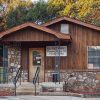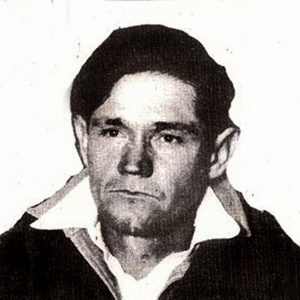calsfoundation@cals.org
Connie Franklin (Alleged Murder of)
The alleged murder of Connie Franklin in 1929 scandalized the state and served to reinforce negative stereotypes about Arkansas in the national mass media. The uproar surrounding the apparent murder only increased with the reappearance of the “victim,” alive and well, shortly before the trial of his accused murderers.
In January 1929, Connie Franklin wandered into the community of St. James (Stone County), where he found work cutting timber and as a farm hand. He claimed to be twenty-two years old, rather than his actual age of thirty-two. He reportedly courted the town’s girls, particularly sixteen-year-old Tillar (or Tiller) Ruminer. According to later testimony by Ruminer, on March 9, 1929, she and Franklin were going to Justice of the Peace Finis Ford’s office to obtain a marriage license. The two were attacked by a gang of men, identified by Ruminer as Hubert Hester, Herman Greenway, Joe White, and Bill C. “Straight Eye” Younger. Hester and Greenway were alleged to have taken Ruminer into the woods and raped her, while Franklin was reportedly tortured, mutilated, and murdered.
A spring 1929 grand jury did not grant an indictment due to the fact that there was no body and no evidence that a crime had occurred other than hearsay from Bertha Burns, who, according to her own account, found the bloody hat belonging to Franklin and subsequently went to Ruminer, demanding to know what had happened and convincing her to report the attack to the authorities. Burns had recently secured a guilty verdict in May 1929 against Alex Fulks, Baxter Canard, and Ross Younger for the flogging she and her husband, Haywood, had suffered at the hands of the three men the previous year.
The sheriff thought he had evidence to continue the investigation into the attack, probing neighbors around the areas of Dry Creek and Cajun Creek over the next several months. Ten days prior to the convening of the fall grand jury, in November 1929, Burns led the sheriff and some deputies to a place in the woods where they found an assortment of charred bones in a pile of ashes. The bones were sent to the state crime lab, and the grand jury, with this new evidence, issued five indictments, adding Alex Fulks to the list, as he was widely considered the ringleader of the group. The five men were soon arrested and held in separate jails for their own protection.
Brothers Hugh Williamson, the prosecuting attorney, and Ben Williamson, the defense attorney, were pitted against each other in front of Judge Marcus Bone, with the trial set for December 16, 1929. (Complicating matters, the Williamson brothers both worked in the firm of their father, president of the Arkansas Bar Association.) As the attorneys prepared their cases, the accused men held to their stories that they had not seen Franklin on said date and that Franklin had left the community just as he had come in. Deputy O. L. Massey from Morrilton (Conway County) was provided information on December 3, 1929, from Elmer Wingo that Franklin had spent the night at the Wingo home after the alleged murder. Many newspapers—including the Arkansas Gazette, the Arkansas Democrat, and the Commercial Appeal of Memphis—ran this information along with a photo of Franklin. On December 7, 1929, Franklin was found by F. K. Marks, a cotton buyer, working on the farm of Murray Bryant near Humphrey (Arkansas County), who convinced Franklin to come to Mountain View (Stone County).
Prosecutor Hugh Williamson warned that “somebody had lied and somebody was going to jail,” stating that there would be a sweeping inquiry into the matter once Franklin’s identity was confirmed. It became known that the man claiming to be Franklin had been drafted into the military in 1926, serving five days before entering the Arkansas State Hospital, from which he escaped in February 1927. He was married and had at least three children, which he had abandoned.
Judge Bone went ahead with the trial while the November grand jury heard evidence to establish the true identify of the man who claimed to be Franklin. During the trial, Ruminer admitted that she had not seen anyone killed or burned, only beaten unconscious. The identify of Franklin was established by a number of persons who knew him before and after the alleged date of the murder and on a comparison of handwriting, fingerprints, and dental and medical records from the Arkansas State Hospital. However, Ruminer continued to deny that the man in the courtroom was the same man she had known before March 9. The jury deadlocked and the defendants were found not guilty.
Some sources explain the alleged murder case as a revenge plot by Burns against Fulks and the others, who were the self-appointed moral enforcers of the rural area. Time magazine covered the trial, as did newspapers throughout the nation. The little town of Mountain View was inundated with reporters, spectators, and gawkers by the thousands, creating a circus-like atmosphere during the week leading up to the trial and during the trial itself. Heavy rains made the roads almost impassable. On December 11, 1929, Governor Harvey Parnell issued a public denouncement of the “yellow” journalism being practiced that branded the people of northern Arkansas as peons and idiots. The cost of the trial was more than $8,000, breaking the already financially burdened county. It was rumored that Judge Bone, upon the not-guilty finding of the jury, ordered that all records of the trial, other than those required by the court, be destroyed so as to end the chain of gossip. However, the story lives on in local folklore.
For additional information:
Allen, Deane. “Man at Batesville Identified as Franklin.” Arkansas Democrat, December 8, 1929, pp. 1, 8.
Blevins, Brooks. “The Arkansas Ghost Trial: The Connie Franklin Case and the Ozarks in the National Media.” Arkansas Historical Quarterly 68 (Autumn 2009): 245-271.
———. Ghost of the Ozarks: Murder and Memory in the Upland South. Urbana: University of Illinois Press, 2012.
Chenout, Fletcher. “Four Cleared of Slaying Franklin,” Arkansas Gazette, December 20, 1929, pp. 1, 7.
“Connie Franklin Reported Living.” Arkansas Gazette, December 5, 1929, p. 1.
“Five Indicted as Climax to Murder Probe,” Arkansas Democrat, November 24, 1929, pp. 1, 6.
“From Baxter Bulletin Files.” Baxter County History 7 (1981): 41–42.
Olsson, Carl. “Startling Franklin Case Development Predicted.” Arkansas Democrat, December 15, 1929, p. 1.
Teske, Steven. Unvarnished Arkansas: The Naked Truth about Nine Famous Arkansans. Little Rock: Butler Center Books, 2012.
Freda Cruse Phillips
Mountain View, Arkansas




 Connie Franklin
Connie Franklin  Connie Franklin Trial
Connie Franklin Trial 



Comments
No comments on this entry yet.